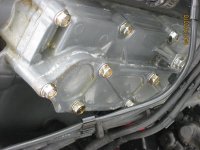"I wouldn't use any sealer
"I wouldn't use any sealer on THAT seal. If the "boss" that it sits in and the mating surfaces are cleaned thoroughly (they look clean)and the seal sits down in there well, it should work fine dry.
Oiling the threads of the bolts is usually only done when specified for a particular torque setting because it DECREASES the amount of force needed to put the fastener in "tension", as in some cylinder head applications, and shouldn't be done unless specified as you can easily overtighten and fail a fastener that way.
I would be more concerned with the manner in which you tighten that long piece down.
Typically, you would snug up all the fasteners finger tight and then, in a two or three step process, (not all at once!) tighten the bolts equally from the center out toward each end in a "criss-cross" fashion.
Tightening from the outer ends inward could create a tendency for the part to "buck up" in the center and it could leak.
One thing I've found about those "form fitting" seals is to not have them laying out in the sun before fit up as the heat will make them expand and then they don't want to lay down in the groove. Conversly, you can use this to your advantage if the seal seems to be a bit "short". You can let it heat slightly and obtain a better fit. Good luck."
 Water Jacket
Water Jacket


